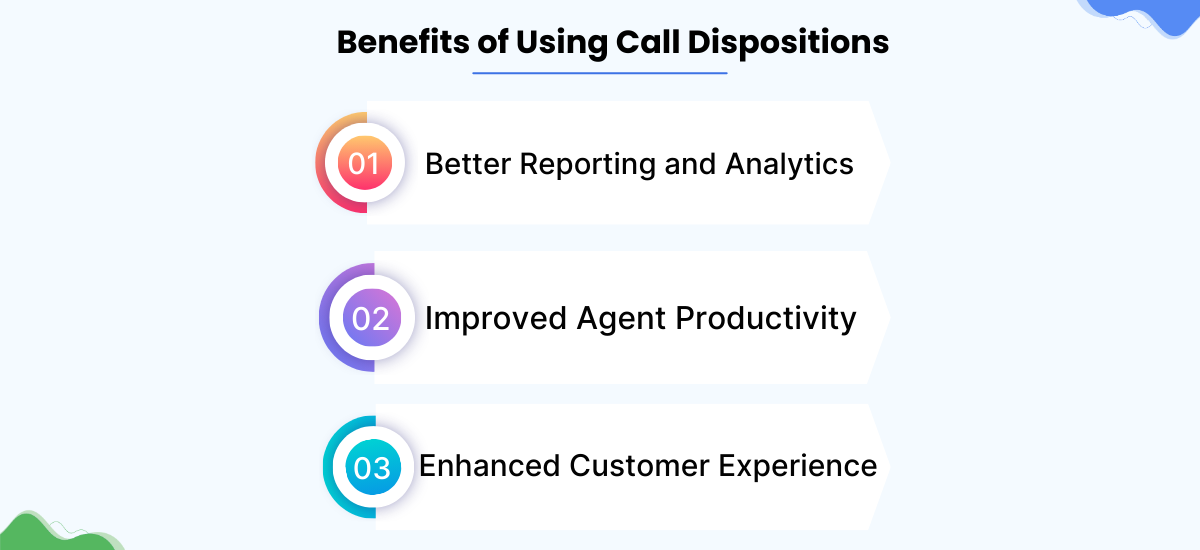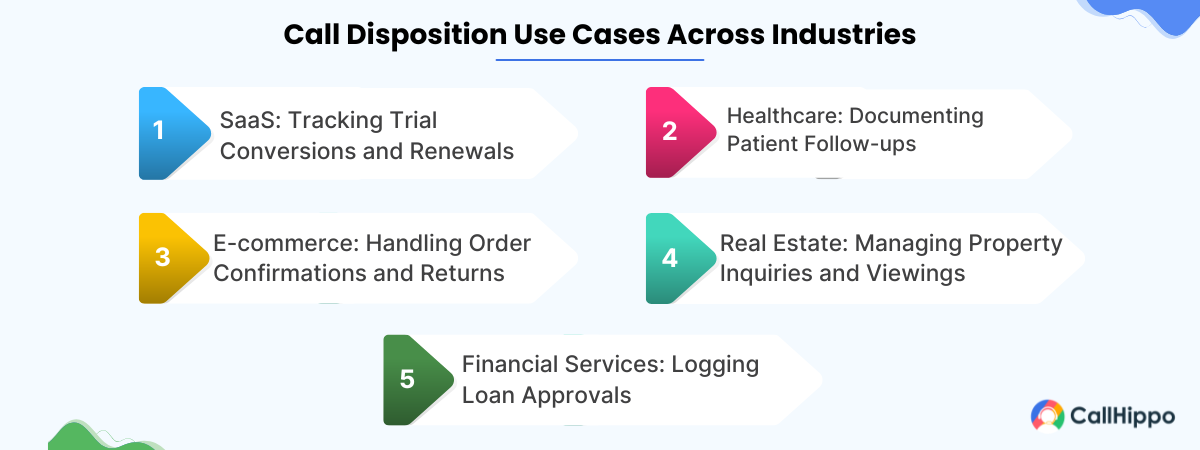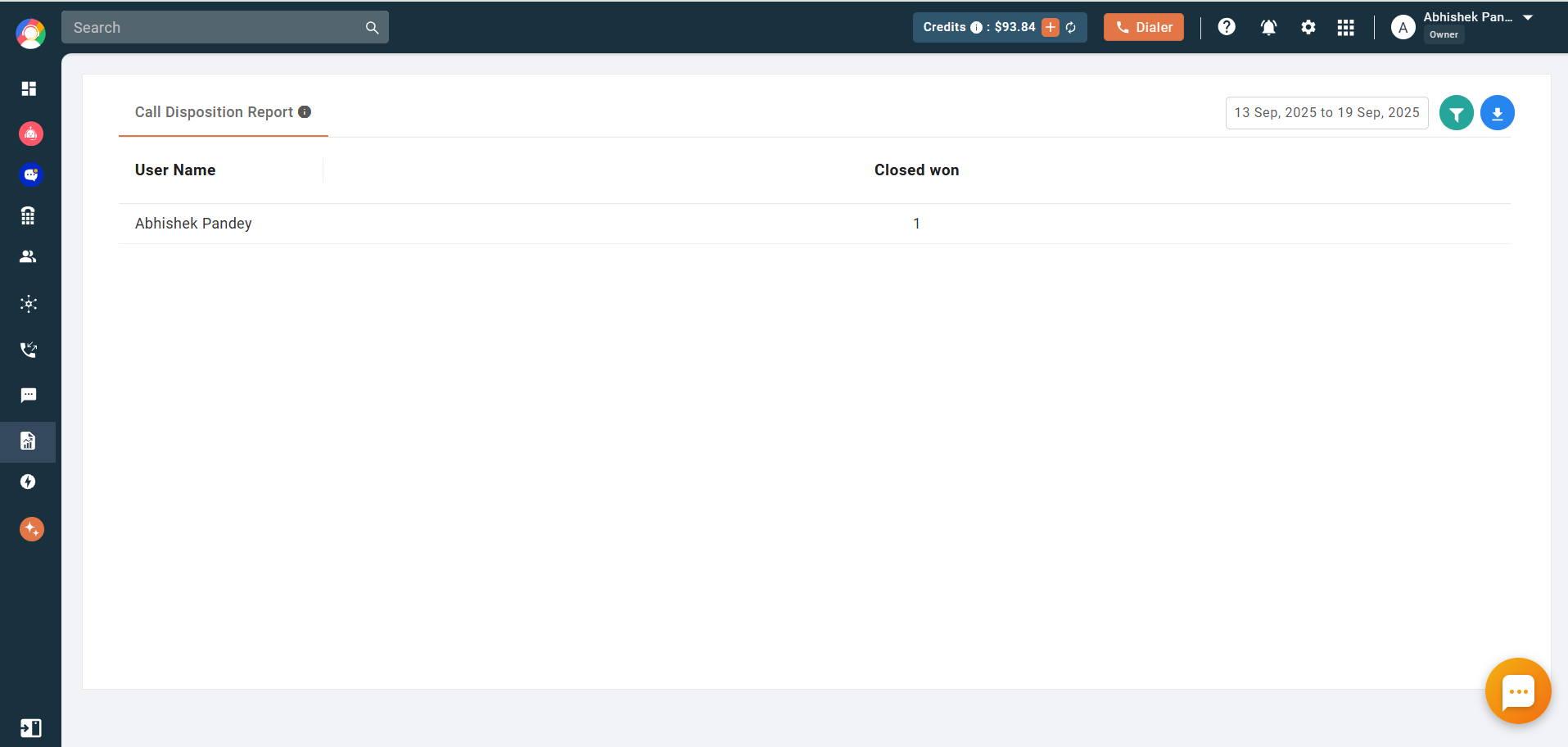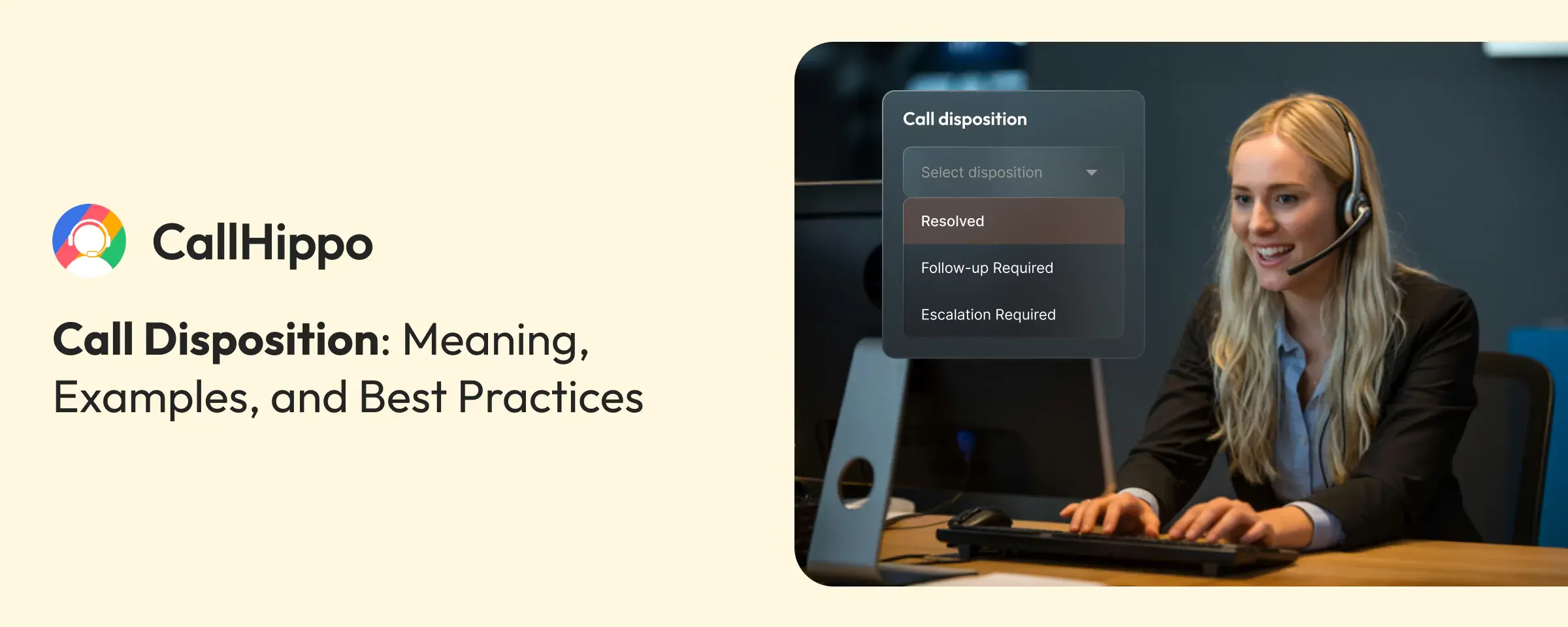Have you ever ended a phone call and wondered, “What just happened here?” Call dispositions give you the answer. They give every call a clear outcome, whether it is a sale, a support issue, or a follow-up. This simple step helps teams avoid confusion and plan the next action.
Call abandonment rates average 6% across the industry. As a result, tracking call outcomes is more important than ever. Dispositions guide what agents do next and make sure each call moves the business forward.
Let’s understand call disposition meaning and delve into this idea more thoroughly in this blog.
What is Call Disposition?
A call disposition means the label that you give to a call once it ends. It records the outcome. For example, whether the call was successful, needed a follow-up, or didn’t connect at all. It is like a brief summary that tells the story of what happened.
These outcomes help both agents and managers. Agents know what to do next, and the managers can see patterns across many calls. When this clarity is there, teams waste less time and make smarter decisions. That is why call dispositions are now a basic feature of modern call centers and contact centers.
Most call centers and sales teams use dispositions to keep their records organized. They also use them to track customer interactions over time. This call disposition function serves as a valuable tool for improving center operations.
It is better to keep the disposition lists short. Ideally, it should be under 15 to 20 codes. This makes it easier for agents to choose the right option quickly. Plus, it keeps reports accurate without overwhelming the team.
How to Set Up Call Dispositions Effectively?
Setting up call dispositions is not complex. You just need the right strategies to make them effective, as they bring clarity to the conversations. This helps both agents and managers.
1. Define Standard Categories
First, make clear call disposition categories. When categories are standard, agents know which option they should actually pick. This avoids confusion. It also helps managers see patterns across the entire team.
- Sales closed, follow-up created, or call not connected. These categories keep things simple and easy to use.
2. Train Agents on Disposition Codes
The thing is: even the best categories will not work if the agents do not understand them. So, you need to simply train them. Walk them through the code and give simple examples.
When agents know how to use dispositions, they record outcomes the same way. This builds consistency. Plus, it makes reports more reliable for the managers and provides consistent visibility into agent performance.
3. Integrate with CRM or Call Center Software
When call dispositions are linked with your customer relationship management or call center software, they become the most useful. This way, call data flows automatically into the system. Integration also helps teams to act faster.
- Follow-up reminders can be created instantly. This saves time and makes sure that no potential customer gets missed.
Call Disposition Examples
Call dispositions look a little different depending on the type of call. A sales team might track outcomes that show deal progress. A support team may log if an issue is resolved or needs escalation. Follow-up calls need their own clear results too.
Let’s see some common call disposition examples.
1. Sales Call Disposition Examples
In sales, dispositions help you in tracking the journey of every lead. Sales call disposition outcomes are crucial for sales managers to understand the sales process.
These labels show how far a prospect is in the funnel. They also help managers see where deals are dropping off. This makes it easier to improve the sales process and enhance customer service delivery.
Common examples are "Interested," "Not Interested," "Sale Closed," or "Call Back Later."
2. Customer Support Disposition Examples
Support calls are all about solving issues and enhancing customer service
These outcomes show if the customer left satisfied or still needs help. Managers can then spot repeat problems and improve processes. It also maintains clarity for the next agent handling the case and helps manage customer interactions more effectively.
Dispositions here can be "Issue Resolved," "Escalated to Specialist," "Customer Unavailable," or "Pending Information."
3. Follow-up Call Disposition Examples
Follow-up calls are just as important as first interactions. A single call often requires follow-up to achieve the desired outcome.
These outcomes make sure no call gets lost. They also help agents prioritize which contacts need attention next.
Here, dispositions could look like "Appointment Scheduled," "Left Voicemail," "No Response," or "Follow-up Required."
Studies show that 80% of deals need five or more follow-ups to close, yet many reps stop after one. When the records are clear, teams save time and keep the customers engaged and improve customer retention. This categorization process ensures better customer service overall.
Common Call Center Dispositions
Call centers handle a lot of calls every day, and not all of them end the same way. Dispositions make it easy to group outcomes into clear categories. This classifying calls approach helps with future reference.
The three most prevalent kinds are as follows:
| Type | Examples of Dispositions |
|---|---|
| Successful Outcomes | Sale Closed, Issue Resolved, Appointment Set |
| Unsuccessful Outcomes | Customer Not Interested, Number Invalid, Hang Up |
| Neutral / Follow-up Outcomes | Left Voicemail, Call Back Later, Follow-up Required |
1. Successful Call Outcomes
These are calls where the goal was achieved. It could be a sale, an issue resolved, or an appointment confirmed. Successful outcomes help teams measure performance. They demonstrate how effectively agents are attending to customer needs and delivering personalized customer service.
2. Unsuccessful Call Outcomes
Not every call ends well. Sometimes the customer says no, hangs up, or the number is invalid. An unsuccessful call attempt might also include cases like a wrong number or a busy signal. These unsuccessful outcomes are still important. They help teams spot trends and refine their strategies for better results in the future.
3. Neutral or Follow-up Outcomes
Many calls don’t end with a final result. Instead, they need further action. Neutral or follow-up outcomes include things like “Left Voicemail” or “Call Back Later.” They keep agents on track and ensure no customer is forgotten. This outcome of a call category helps with follow-up actions.
Call Disposition Codes List for Managing Inbound and Outbound Calls
Disposition codes make it easy to record what happened during a call. They act like quick tags that keep records clear. Below are common codes used for both inbound calls and outbound calls.
| Inbound Call Codes | Outbound Call Codes |
|---|---|
| Issue Resolved | Sale Closed |
| Escalated to Specialist | Left Voicemail |
| Customer Unavailable | No Response |
| Information Provided | Call Back Later |
| Pending Customer Action | Not Interested |
You can customize these codes for your business. You just need to keep them simple so that the agents can record outcomes quickly without confusion. This call disposition list serves as valuable data for analyzing communication processes.
Benefits of Using Call Dispositions in a Call Center
Call dispositions don’t just label the call. They create real value for both teams and the customers. The key benefits that make them an essential part of call center operations are as follows:

1. Better Reporting and Analytics
Dispositions give managers accurate data through call disposition analytics. They can see which calls convert, which need follow-ups, and which fail. When these insights are clear, teams can spot trends faster.
Plus, they make smarter decisions to improve performance and gain a comprehensive picture of their operations.
2. Improved Agent Productivity
When agents record outcomes clearly, they don’t repeat the same steps then which helps in call center monitoring. Each call builds on the last using previous interactions. This saves time and keeps agents focused.
Also, it helps them manage more calls without losing track and enables them to handle disposition calls more efficiently.
3. Enhanced Customer Experience
Neither do the customers like repeating themselves. With clear dispositions, agents know the full history of every call. This leads to faster resolutions and fewer errors.
This way, customers receive a smoother experience that makes them feel valued and enhances customer satisfaction.
Best Practices for Call Disposition Management
When you manage the call dispositions well, it ensures that they stay useful over time. A few simple best practices can make the process smoother for both agents and managers.
1. Keep Dispositions Clear and Consistent
Agents should never guess which option to choose. Keeping clarity is important. Dispositions must be simple, with names that are easy to understand. For example, “Issue Resolved” is clearer than “Case Closed.”
Consistency matters too. If everyone uses the same terms, records will be uniform. This avoids confusion when managers review reports across teams and helps with categorizing calls effectively.
2. Use Automation to Reduce Manual Errors
Manual entry can lead to mistakes. Automation helps reduce those errors. For example, linking dispositions to call outcomes in the system makes it faster for agents.
Automation also saves time. Agents spend less energy logging calls and more time helping customers. This creates smoother workflows and fewer reporting gaps while improving the disposition function overall.
3. Regularly Update Based on Business Needs
Business needs change. A code that worked last year may no longer be relevant. That is why it is important to review and update dispositions regularly.
Removing unused codes keeps the list short and focused. Adding new ones ensures the system matches your current goals. This keeps dispositions practical and effective for sales calls and customer service interactions.
- A SaaS provider restructured its call disposition strategy to make outcomes clearer and more actionable. Categories like “Demo Booked”,“Follow-up Required”, and “Not Interested”replaced vague labels.
- The results were clear. Within three months, the company saw a 30% increase in conversions, a 25% drop in wasted calls, and a 40% boost in scheduled demos and appointments. This showed how well-planned call dispositions can directly impact growth.
Role of Call Dispositions in Compliance and Data Privacy
Call dispositions are not just operational tools. They also support compliance and protect customer data.
1. Recording Call Outcomes Without Storing Sensitive Data
Dispositions summarize the call outcome without storing personal details. For example, “Payment Issue” can be logged without writing down the card number.
This balance gives managers insights into call trends through disposition data. Plus, it keeps the private data safe. It also reduces risks if records are ever reviewed externally.
2. Meeting GDPR, HIPAA, and Other Regulatory Requirements
Different industries face strict compliance rules. GDPR in Europe and HIPAA in healthcare are two common examples. Dispositions help businesses meet these rules by keeping outcomes standardized and secure.
Instead of storing sensitive notes, teams log outcomes that meet legal standards. This protects customers and avoids costly penalties while maintaining the call disposition feature’s effectiveness.
Industry-Specific Call Disposition Use Cases
Different industries use call dispositions in different ways. The core idea remains the same. But the disposition categories change as per the business needs. Let’s see a few examples:

1. SaaS: Tracking Trial Conversions and Renewals
In SaaS, dispositions track how trials and subscriptions move forward. Agents can log outcomes like “Trial Converted,” “Renewal Confirmed,” “Churn Risk.” or “Closed Won”.

These outcomes help teams see where users drop off. They also guide the right follow-ups. For example, sending reminders or offering discounts to retain customers and address the customer’s issue effectively.
2. Healthcare: Documenting Patient Follow-ups and No-Shows
Healthcare call centers rely on dispositions to track patient interactions. Examples include “Appointment Confirmed,” “Follow-up Scheduled,” or “No-Show.”
This information helps staff manage busy schedules. It also ensures patients don’t miss important checkups or treatments. This leads to better care overall and puts each interaction in a particular category for tracking.
3. E-commerce: Handling Order Confirmations and Returns
For businesses in the e-commerce sector, dispositions simplify customer communication. Codes like “Order Confirmed,” “Return Requested,” or “Refund Processed” keep records organized.
With these outcomes logged, agents can provide faster support. It also ensures no customer query gets lost in the middle of order management. Sales reps can quickly identify if the caller showed interest in additional products.
4. Real Estate: Managing Property Inquiries and Viewings
Real estate agents often manage multiple prospects at once. Dispositions such as “Viewing Scheduled,” “Offer Made,” or “Not Interested” make tracking easier.
They help agents follow up with serious buyers. They also highlight which properties attract interest. This gives valuable insights to make sales strategies in the future and handle more calls efficiently.
5. Financial Services: Logging Loan Approvals and Rejections
In financial services calls , every call outcome matters. Dispositions like “Loan Approved,” “Loan Rejected,” or “More Documents Needed” provide clarity.
These records ensure compliance, and they keep the process smooth for customers. They also help banks and lenders identify common reasons for rejections and improve policies. If a complaint is registered during the call, it can be properly categorized for follow-up.
Challenges and Mistakes to Avoid with Call Dispositions
Call dispositions can add great value, but only if they are managed well. Some common mistakes make them less effective and harder to use. Here are the main ones you should avoid.
1. Using Too Many or Overly Complex Disposition Codes
When there are too many codes, it confuses the agents. Long or complicated names also slow them down.
The goal should always be simplicity. When there are fewer and clearer options, it becomes easier to record calls and keep the data reliable for analysis. This applies whether handling a common call or a complex customer inquiry.
2. Lack of Standardization Across Teams
If different teams use different terms, the records lose meaning. One agent may log “Callback Needed,” while another uses “Follow-up Required.”
This mismatch causes confusion in reports. Standardizing the codes ensures everyone speaks the same language and records remain consistent across all customer interactions.
3. Failing to Train Agents Properly on Dispositions
Even the best system fails if agents don’t know how to use it. If they don’t receive the proper training, they may log the wrong outcomes or skip the step entirely.
Short and simple training sessions help solve this. Examples and practice keep agents confident and consistent in their approach to disposition analytics.
4. Ignoring Regular Updates and Business Changes
Business needs evolve, but disposition lists often stay the same for years. Outdated codes can make reports less useful.
Reviewing and updating the list regularly keeps it aligned with current goals. This ensures the system grows with the business, not against it. Whether you need follow-up email tracking or appointment scheduling codes, keeping the list current is essential.
Conclusion
Call dispositions may look small, but they make a big difference. They bring order to calls. They guide agents on what to do next. And not to forget, they give managers clear insights to improve performance through disposition analytics.
Use it the right way and think of it as a habit that turns every call into an action. The result you get is smarter teams and stronger relationships. Whether you require follow-up or need to track follow-up needed scenarios, proper call disposition management makes all the difference.
FAQs
1. How can call dispositions improve sales and customer support?
Call center dispositions improve customer support because they give every call a clear outcome. In sales, they show where prospects stand in the funnel and guide the next step. In support, they help agents see past issues quickly, resolve problems faster, and deliver a smoother customer experience. This comprehensive approach to call disposition FAQs helps teams understand the value better.
2. How do you create effective call disposition codes?
Start by keeping code simple and easy to understand. Use standard terms like “Follow-up Needed” or “Issue Resolved.” Train agents with examples so everyone uses them consistently. Review the list often, add new codes when needed, and remove ones that no longer add value. Consider whether you need a follow-up call category or specific codes for appointment-scheduled scenarios.
3. What is the difference between a call outcome and a call disposition?
A call outcome is the actual result of the call, like a sale made or a customer request denied. A call disposition is the label given to record the result in the system. It is a quick summary that helps teams track and analyze calls for future reference.

Subscribe to our newsletter & never miss our latest news and promotions.








